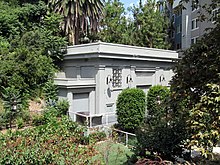Hollywood Subway
It ran from its northwest entrance in today's Westlake district to the Subway Terminal Building, in the Historic Core, the business and commercial center of Los Angeles from around the 1910s through the 1950s.
Numerous lines proceeded from the San Fernando Valley, Glendale, Santa Monica and Hollywood into the tunnel in Westlake and traveled southeast under Crown and Bunker Hill towards the Subway Terminal.
The tunnel's northwest entrance, the shed of what was formerly an electric substation, and the site of the former yard, are just downhill from 299 South Toluca Street, in Westlake.
Early plans for a subway line in Los Angeles included the same alignment as the built tunnel, but continuing further northwest to a point near Bimini Baths and providing connections in Hollywood.
[2] Over about one mile of track, the Subway linked trains heading towards the intersection of Beverly and Glendale Boulevards in Westlake with Los Angeles's newest train station and second electric rail hub, which lay underneath the Subway Terminal Building at the corner of Fourth and Hill Streets, by Pershing Square (due east).
The Subway funneled trains through Westlake and Hollywood to Santa Monica, North Hollywood, and Glendale, cutting seven miles (11 km) or more off similar journeys on rails running along Alameda Street and Exposition Boulevard, which funneled train traffic south and east in Southern California to the other hub, and headquarters, the Pacific Electric Building.
Ridership through the Subway reached its peak during the Second World War: in 1944, 880 trains per day used the tunnel, serving an estimated 65,000 passengers daily, reckoning out to more than 20 million riders a year.
The last electric train to carry passengers — adorned with a banner reading, To Oblivion, left the Belmont Tunnel on the morning of June 19, 1955.


